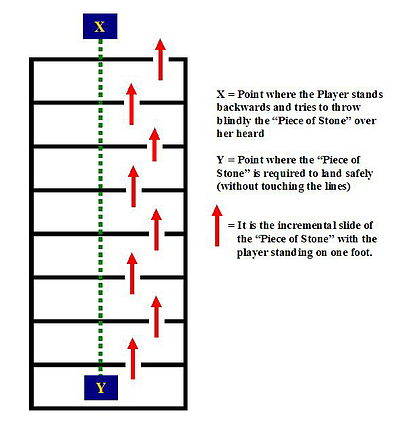- Chindro
-
Chindro (also known as Stapoo or Kidi Kada) is a popular rural game of Indian Sub-Continent. Though mostly it is considered as a rural game but it is frequently played in many urban areas as well. Primarily it is a favorite pass time of small and teenage girls but young boys can also take part.
Contents
Equipment required
The game costs nothing and requires only two small things. A small piece of Chalk or Coal is needed to draw a “Playing Court” and a square or round piece of a flat stone (usually not bigger than 4 inches in diameter) is used as the playing object. As a matter of fact most of the time an empty small tin box of a shoe polish is filled with sand and is used as the playing object.
How to Play
One of the participant draws a “Playing Court” on a flat surface (usually the floor of alleys) with the help of a piece of coal or chalk. The size of the “Playing Court” depends upon the wishes of the participants and may thus vary greatly. For example if all the participants agree to have a “Playing Court” of Eight Boxes (2 feet by 4 feet each) then that constitutes the “Playing Court”. Therefore, there are no set parameters for drawing the “Playing Court”.
Once the “Playing Court” is drawn then each participant takes turn. Initially the player would stand backwards at one side of the “Playing Court” and then throw the piece of stone blindly over her head so that it may land inside the farthest box of the “Playing Court”. If it lands successfully inside the designated box (without touching any lines) of the “Playing Court” then the player would usually take of her shoes and stand barefoot beside that piece of stone with one foot in the air. Afterwards she would push that piece of stone (in a single try) with reasonable force so that it may successfully slide in the adjoining box. If it successfully slides into the adjoining box (once again without touching any of the lines) then the player carries on doing the same until the piece of stone is successfully out of the “Playing Court” and the player is back at the place from where she threw the stone blindly. Once the player is successfully out of the “Playing Court” then she is allowed to stand on her both feet.
Consequently the player’s turn prematurely ends when:
- The player can no longer stand on one foot and both feet touch the “Playing Court” area, or
- The stone stops on one of the lines, or
- Slides out of the “Playing Court” before it could reach the last box.
Taliban's Ban on Children playing in alleys
Chindro was played in great number among the young Demographics of Afghanistan girls. It was during the Taliban rule that among many other sports for girls, Chindro was also completely banned in Afghanistan[1].
External links
Categories:- Children's games
Wikimedia Foundation. 2010.

